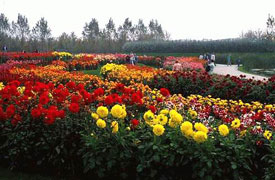


Home
Flowers &
Indoor Plants
Fruits & Nuts
Ornamentals
Vegetables
Special Topics
Resources
Glossary

|
Dahlia Dahlia pinnata (dal-ya pin-a-ta)  


Click on thumbnails for larger image. |
 |
What about it? Dahlias come from the mountain regions of Mexico and Guatemala. They are up to 4 feet tall, erect, and branching. Disk flowers are yellow and ray flowers can be red, pink, purple, or white. Sometimes Dahlia's flower head is said to be nodding. Dahlias are considered "horticultural annuals" which means that they are perennials that bloom 1 year after the seed has been planted. What is it used for? The annual dahlia varieties are used as bedding plants, but dahlias are also found as cut flowers and border plants. The tall types are grown from tuberous roots. They flower primarily throughout July and August. Where does it grow? How do we grow it? Dahlias like moist, fertile, well-drained soil and full sun exposure. It is important to keep them adequately watered. The tall dahlias will require staking. For maximum flower size you should remove the tiny flowers on side shouts as they appear. What are its primary problems? Gray mold may grow on flowers and powdery mildew may be a difficulty late in the season. Aster yellows is not a serious threat in New York, but will prevent the buds from opening completely, or they will fail to open at all. How do we propagate it? Dahlias will flower one year after they have been planted. Plan accordingly but always sow the seeds indoors.
© Copyright, Department of Horticulture, Cornell University. |